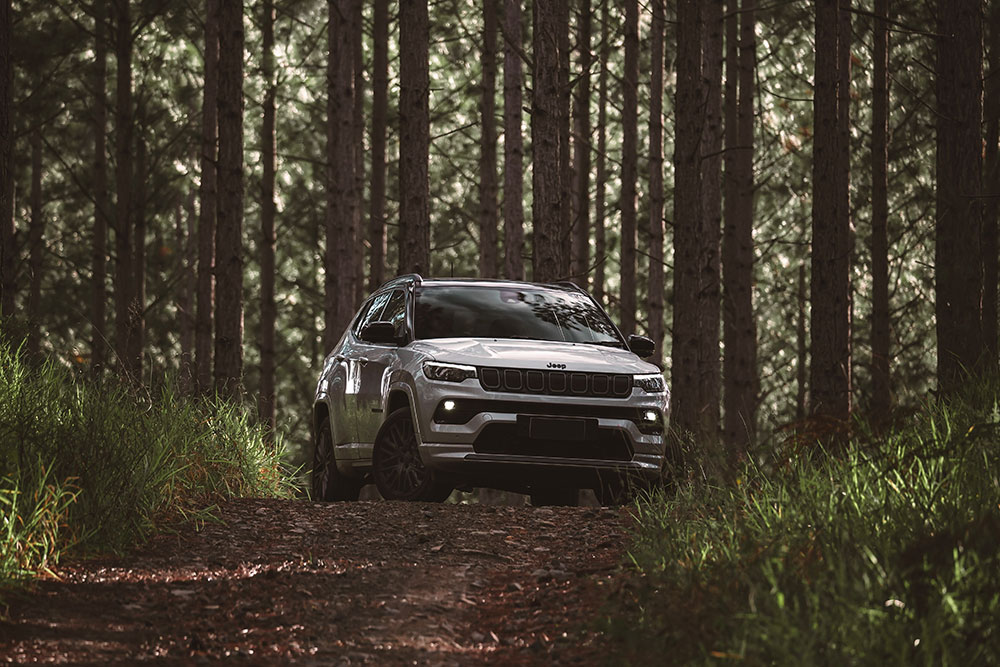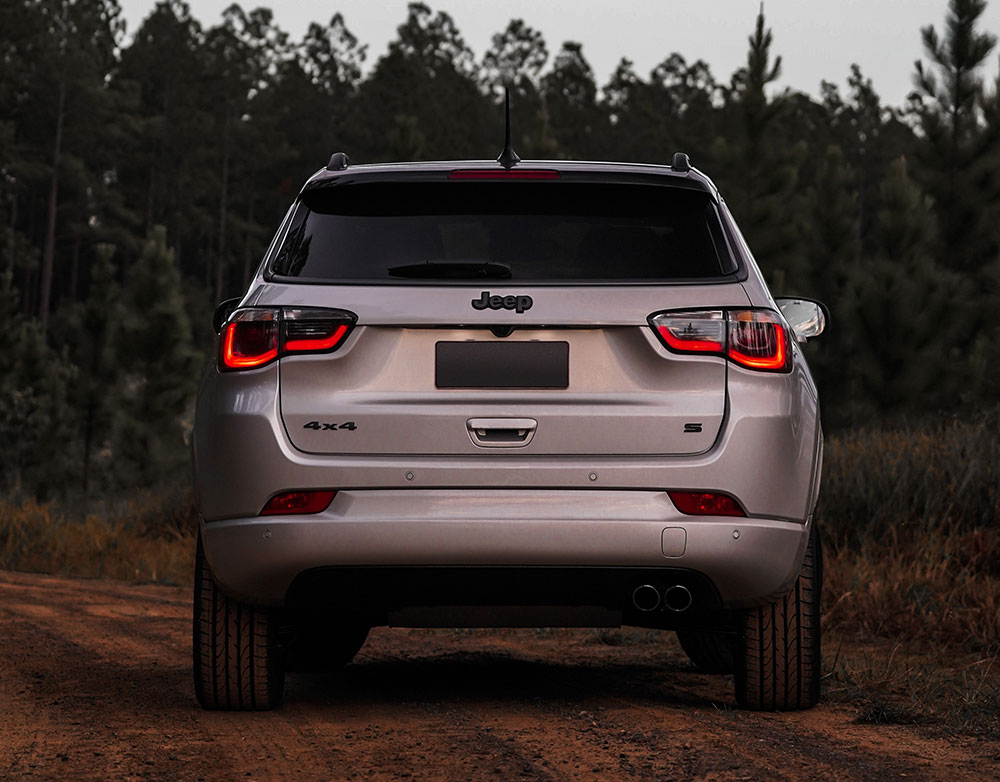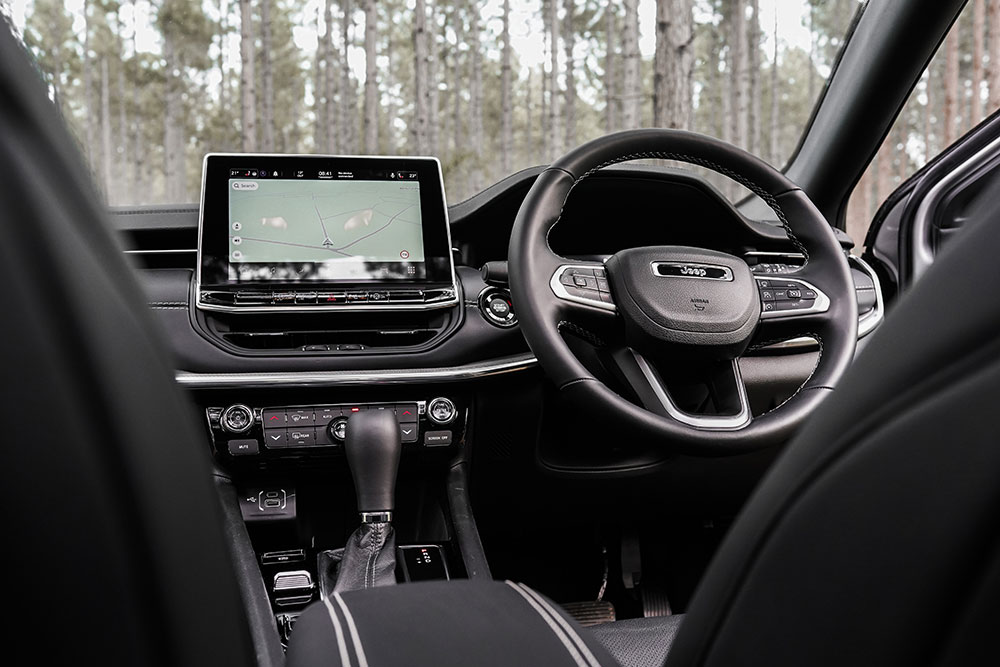Jeep Compass Trailhawk review

Jeep’s offering in the small SUV market, the Compass, has been given a substantial facelift delivering a significantly improved interior look and finish and featuring enhanced technology and driver assistance systems.
Fittingly, there are four points to the Compass range, with prices starting at $39,950 for the front-wheel-drive Night Eagle.
It’s followed by the Limited ($45,350), the S-Limited ($48,350) and the flagship Trailhawk tested here, which tops the range at $52,650.
At this sort of money, the Indian-built Compass, particularly the higher-spec versions, is bumping up against some well-equipped and credentialed opposition across the small, medium, and even large SUV segments, including small SUVs from prestige brands like Audi and BMW.
Our Trailhawk tester came fitted with the $3,950 Trailhawk Premium Package, which comprises a dual-pane panoramic sunroof, ventilated and heated front seats, heated steering wheel and an Alpine nine-speaker premium audio system.
The Trailhawk is available with a turbodiesel engine only, making it something of a rarity in the small SUV segment, along with the BMW X1 sDrive 18d and SsangYong Tivoli.
The rest of the Compass range is powered by a naturally aspirated 2.4-litre four-cylinder petrol engine.
All models, except the Night Eagle, send power to each corner via a nine-speed auto and Jeep’s Active Drive Low part-time all-wheel drive system.
These all-wheel drive variants are also equipped with Jeep’s Selec-Terrain traction management system, which features settings to optimise traction on rock, sand/mud, and snow.
Other features designed to enhance the Trailhawk’s all-terrain ability include taller riding off-road suspension, 17-inch wheels with Falken Wild Peak H/T tyres, front and rear recovery hooks, underbody bash plates to protect vitals like the transmission and fuel tank, and a revised 4.334 rear axle ratio.
A full-size spare wheel in place of the space saver spare fitted to other models is a most welcome addition.
The torque-proportioning AWD system drives the front axle under most conditions, but automatically shuffles drive to the rear when required.
A 4WD lock button allows the driver to lock drive to the rear axle for slippery off-road conditions, but with a single-speed transfer case rather than a more purposeful dual range system, there’s no additional low-range reduction available for serious off-road crawling.
Instead, the button keeps the transmission in low gear where overall reduction is around 20:1 compared to a ratio of around 40:1 that’s provided by more dedicated dual-range transfer cases.

The relative lack of crawling ability tells in tougher conditions, including steep ascents and descents, with the driver forced to rely on the less effective hill descent control system in the latter instance, to assist with controlling speed.
That said, the Trailhawk is one of Jeep’s ‘trail-rated’ models, which means it will take you further off-road than most of its small soft-roader competitors, except for Suzuki’s Jimny.
It’s worth noting, too, that other all-terrain models with low-range gearing, such as the Isuzu MU-X and Mitsubishi Pajero Sport, can be had for similar money (spec dependant) to the Jeep and these will ultimately offer superior off-road capability.
This latest refresh brings mild exterior styling revisions and cosmetic treatments specific to each grade, while retaining signature Jeep styling cues including the seven-slot grille.
The company claims improved functionality for the Trailhawk thanks to its bumpers, fog lamps and the camera radar now being housed in a higher position, affording greater protection during off-road use.
It's under the Trailhawk’s metal skin where the most obvious and welcome changes have taken place.
A complete interior redesign gives it a more modern and premium look, including improved oddments storage capacity.
There’s also a new dashboard that’s dominated by a 10.1-inch ultra-HD touchscreen using Jeep’s latest Uconnect 5 infotainment system, with integrated TomTom navigation and voice command.
Standard across the range are handy tech features like wireless smartphone charging, Apple CarPlay and Android Auto, and DAB+ radio.
Ahead of the driver on all models bar the entry-level Night Eagle is a 10.25-inch digital instrument cluster.
Other notable features of the Trailhawk include leather-trimmed seats with red stitching accents, all-season floor mats, and a new 360-degree surround-view camera system.
The neatly finished interior is only let down by the inexplicably cheap and flimsy feeling switch stalks.
All variants of the Compass, including the Trailhawk, feature six airbags as well as a suite of advanced driver assistance systems (ADAS) technology, including intelligent speed assist, traffic sign recognition, pedestrian emergency braking, forward collision warning, rear cross path detection, adaptive cruise control with stop/go function, trailer sway control, blind-spot monitoring, drowsy driver detection and active lane management system.
Unfortunately, the forward collision warning calibration on our test vehicle was overly alarmist, even when adjusted to its lowest sensitivity.

Likewise, the lane management system felt nervous and inconsistent in its operation, even when dialled back to its lowest setting, with the result the vehicle felt like it was pinballing down the road from one side of the lane to the other.
We ended up switching off the lane management, to halt its annoying steering inputs.
On the drivetrain front, the 2.0-litre turbodiesel exhibits some initial lag when getting off the line but otherwise provides sufficient urge for most conditions. With maximum outputs of 125kW/350Nm the diesel easily eclipses the petrol engine’s 129kW/229Nm.
The nine-speed auto gearbox is a suitable match up for the diesel, though paddle shifters aren’t provided for manual shifting and moving the shift-lever of our tester across into manual mode felt unusually stiff.
A Sport mode is also missing from the features list, but Jeep nonetheless claim the Trailhawk can gallop from 0-100km/h in a respectable 9.7 seconds.
In addition to its considerable torque advantage, the oiler’s fuel consumption is more frugal than the petrol models, returning a combined cycle 6.9L/100km. The engine is also Euro 6 emissions compliant, requiring Adblue urea exhaust fluid to treat the exhaust gases through the selective catalyst reduction system.
Out on the road, the Trailhawk’s suspension does a decent job of blotting out most lumps and bumps, though a series of blemishes such as road patching can have it feeling a bit fidgety.
Dynamically it feels secure and sufficiently competent but falls short of being sporty or approximating the finesse of the class leaders’ handling skills.
The steering is light and consistent but a tad remote and would benefit from some additional road feel.
Where the Compass can show many of its small SUV peers the way is interior space.
Leg and foot space in the rear is quite generous by class standards, though headroom is only fair.
The 438 litres of cargo space accessed via a ‘smart’ power tailgate is also good in class terms, while a flat-folding split rear seat allows larger items to be carried.
Jeep provides a competitive five year/100,000km warranty and five-year capped price servicing with service intervals of 20,000km/12mth for the diesel and 12,000km/12 months for petrol models.
The Trailhawk is rated to tow a maximum of 1,500kg with a maximum ball load specification of 150kg.
The updated Compass Trailhawk advances its cause thanks to numerous improvements, while delivering more interior space and off-road ability than most of its competitors. But the drive experience is only mid-field and falls short of the class leaders.
Unless the Jeep badge holds magical appeal for you, the relatively high price point could well see potential buyers weighing it against the range of quality alternatives available in this hotly contested corner of the SUV market.
Key stats
- MLP: $52,650
- ENGINE: 2.0-litre turbodiesel four-cylinder.
- ANCAP CRASH RATING: 5 stars (2017)
- FUEL CONSUMPTION (combined cycle, litres/100km): 6.9 (181g/km CO₂)
- FOR: Improved interior and technology, one of the few small SUVs with a diesel option, generous interior space, more off-road skills than many class competitors, equipment levels, full-size spare on Trailhawk.
- AGAINST: Drive experience falls short of class leaders, flimsy feel to control stalks, ADAS calibration shortcomings, price of higher grades.
Related topics
Things to note
The information in this article has been prepared for general information purposes only and is not intended as legal advice or specific advice to any particular person. Any advice contained in the document is general advice, not intended as legal advice or professional advice and does not take into account any person’s particular circumstances. Before acting on anything based on this advice you should consider its appropriateness to you, having regard to your objectives and needs.
Insurance Products (excluding Travel Insurance) are issued by RACQ Insurance Limited ABN 50 009 704 152 (RACQI) and arranged by its agent, RACQ Distribution Services Pty Ltd (RDS) ABN 35 116 361 650, AFSL 567130 and RDS' authorised representatives (including RACQ Operations Pty Ltd ABN 80 009 663 414, AR No. 234978 (RACQO). Conditions, limits and exclusions apply. RDS and RACQO are in the RACQ group of companies. One of the companies in the RACQ group of companies has a minority shareholding in RACQI.
RDS and RACQO have not taken your personal objectives, circumstances or needs into account when preparing advice regarding insurance products and you will need to consider whether the advice is appropriate for you. Read the Product Disclosure Statement (PDS) and any applicable Supplementary PDS before making a purchase decision on this product. You can also access our Target Market Determinations on this website. RDS receives a commission from RACQI for the policies it arranges. RACQO receives fees paid for services it provides to RDS. Further details about remuneration are available on request prior to purchasing.
Banking and loan products issued by Members Banking Group Limited ABN 83 087 651 054 AFSL/Australian credit licence 241195 trading as RACQ Bank. Terms, conditions, fees, charges and lending policies apply. This is general advice only and may not be right for you. This information does not take your personal objectives, circumstances or needs into account. Read the disclosure documents for your selected product or service, including the Financial Services Guide and the Terms and Conditions, and consider if appropriate for you before deciding.
Except for RACQ Bank, any RACQ entity referred to on this page is not an authorised deposit-taking institution for the purposes of the Banking Act 1959 (Cth). That entity’s obligations do not represent deposits or other liabilities of RACQ Bank. RACQ Bank does not guarantee or otherwise provide assurance in respect of the obligations of that entity, unless noted otherwise.
RACQ Bank subscribes to the Customer Owned Banking Code of Practice which establishes higher standards than the law requires. The Code reflects modern consumer expectations and developments in approaches to issues such as consumer vulnerability, guarantors, and supporting customers through financial hardship. Please read our Customer Owned Banking Code of Practice page for more information.
RACQ Operations Pty Ltd (ABN 80 009 663 414 AR 000234978) and Members Travel Group Pty Ltd (ABN 45 144 538 803 AR 000432492) are acting as an Authorised Representative of the issuer of the insurance, Tokio Marine & Nichido Fire Insurance Co., Ltd. (ABN 80 000 438 291 AFSL 246 548). Any advice set out above is general in nature only, and does not take into account your objectives, financial situation or needs. Before purchasing any travel products, please consider the RACQ Travel Insurance Product Disclosure Statement (PDS) and the Target Market Determinations (TMDs) that apply to these products. Whilst the PDS outlines the Terms and Conditions of these products, the TMDs outline the intended class of customers that comprise the target market for these travel products. This will allow you to consider which products best suit your objectives, financial situation and needs and consider the products appropriateness to your personal circumstances. TMDs also outline matters involving the distribution and the review of these products. The PDS, Supplementary PDS and TMDs for each travel product can be found here.
